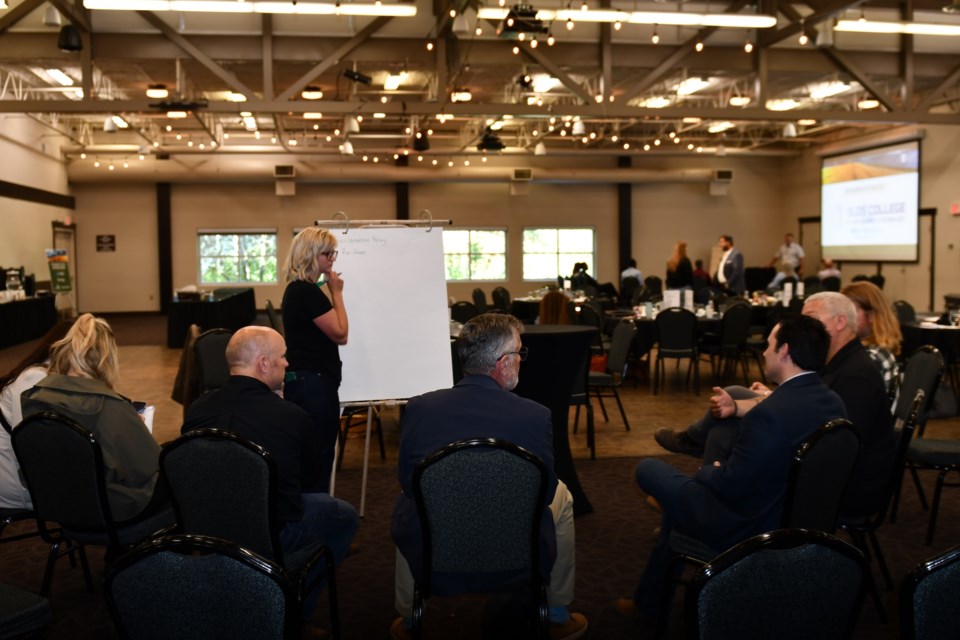OLDS — A couple of Olds College officials are hoping a caucus meeting hosted by the college will give farmers and ranchers confidence that they can not only safely grow crops and raise livestock with solar panels on their land but that those panels are another source of revenue.
That practice is called agrivoltaics. The one-day caucus, held June 26 in the Alumni Centre, brought together about 60 academics, agricultural producers, politicians and representatives of Agrivoltaics Canada to discuss it.
“We talked about things like regulations,” Ike Edeogu, an applied research manager at Olds College said during an interview with the Albertan.
“What are the regulations to allow for energy production, small scale? Much larger scale, you need environmental assessments or kind of feasibility studies done, some of which can be fairly expensive.”
"We need to have answers, not just for solar energy producers in terms of agriculture, but even agricultural producers.”
Edeogu said the need for research came up “a lot” during the caucus. It was noted that agrivoltaics is being practised in Israel.
He said farmers and ranchers don’t need to just lease land for solar panels and leave it. They can still raise crops or livestock between those panels.
Edeogu noted that commonly, sheep are seen grazing between solar panels but said opportunities aren’t limited to just sheep.
“There are other forms of ag, like cropping cereals, oil seeds, like canola, pulses, like sour beans and stuff and maybe even doing it in rotation so that you're successful, so it's energy production and agriculture production on the same piece of land.”
Edeogu said evidence was given of an Alberta farmer and an American farmer whose operations were made more profitable due to agrivoltaics.
He said research is needed to demonstrate the viability of that kind of production “not just in Alberta, the whole of Canada,” adding that currently, academics tend to look to Europe or other parts of the world for answers from that research.
“What I took from it is, there is a lot of interest (in the potential of agrivoltaics),” he said.
Edeogu said right now, Agrivoltaics Canada is run with volunteers. One option, he said, might be to form an Alberta chapter of that organization with its own executive director to fund research, publicize agrivoltaics and its potential, and lobby the provincial government for changes that would benefit the industry.
He said one suggestion to publicize agrivoltaics would be to have a display during the Calgary Stampede next year.
Semeton Amosu, a research associate in agrivoltaics and soil health who works on Edeogu’s team, is also enthusiastic about the potential of agrivoltaics.
He said he was “kind of instrumental” in arranging for the caucus to be held at Olds College.
Amosu said there was a real need for the caucus and for publicity about agrivoltaics to get out because too many people talk about conflict between the solar energy industry and agriculture when there’s potential for both to exist and thrive together.
“It's actually a dual use of the land and profitable, really, at the end of the day,” he said.
“We had discussions along the areas of policies,” Amosu said. “What should we pitch the government to make it easier for both the solar operators and the producers to also accept this innovation?”
The provincial government decided in 2024 that projects can no longer proceed on prime Class 1 and Class 2 farmland unless they prove they can co-exist with crops and/or livestock.
Amosu said Olds College is involved in some research projects already underway or some are planned to take a deep dive into agrivoltaics and its potential.
“We also have a couple of solar operators that we're partnering with who want to fully practice agrivoltaics and we have a few proposals already for them to adopt, so that we can work with them as well,” he said.
Amosu said producers may have to make some adjustments for agrivoltaics to be successful on their land.
“They may not be able to use their commercial equipment,” he said. “Maybe smaller machines will have to work through in between the panels, among all that. I mean it involves a lot of conversations for them, what needs to be done, what can be done.
“We presented about five plus or six research models that they could adopt, from crops to livestock to the ones that help with biodiversity.”
Amosu said there was even discussion about how beekeeping could work well in agrivoltaics.
“Of course, environmental sustainability is important. Soil health has to be conserved and the climate itself,” he said.
Amosu said agrivoltaics could prove to be a source of employment, as the land is tended.
He predicted that a document summarizing what was learned from the caucus will likely be compiled by the end of the summer holidays.



